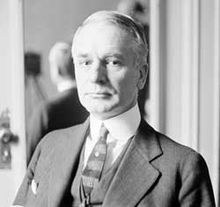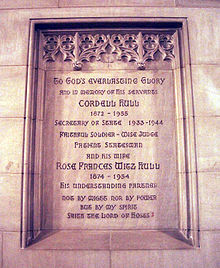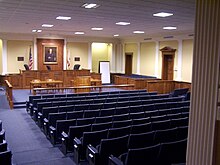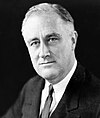Cordell Hull
Cordell Hull | |
|---|---|
 | |
| 47th United States Secretary of State | |
| In office March 4, 1933 – November 30, 1944 | |
| President | Franklin D. Roosevelt |
| Deputy | William Phillips (1933–1936) Sumner Welles (1936–1943) Edward Stettinius, Jr. (1943–1944) |
| Preceded by | Henry L. Stimson |
| Succeeded by | Edward Stettinius, Jr. |
| United States Senator from Tennessee | |
| In office March 4, 1931 – March 3, 1933 | |
| Preceded by | William Emerson Brock |
| Succeeded by | Nathan L. Bachman |
| Member of the U.S. House of Representatives from Tennessee's 4th district | |
| In office March 4, 1923 – March 3, 1931 | |
| Preceded by | Wynne F. Clouse |
| Succeeded by | John R. Mitchell |
| In office March 4, 1907 – March 3, 1921 | |
| Preceded by | Mounce Gore Butler |
| Succeeded by | Wynne F. Clouse |
| 17th Chairman of the Democratic National Committee | |
| In office 1921–1924 | |
| Preceded by | George White |
| Succeeded by | Clem L. Shaver |
| Member of the Tennessee House of Representatives | |
| In office 1893-1897 | |
| Personal details | |
| Born | October 2, 1871 Olympus, Pickett County, Tennessee, U.S. |
| Died | July 23, 1955 (aged 83) Washington, D.C., U.S. |
| Political party | Democratic |
| Spouse | Rose Frances (Witz) Whitney (1917–1954; her death) |
| Alma mater | Cumberland School of Law |
| Profession | Politician, Lawyer |
| Signature | |
| Military service | |
| Branch/service | Tennessee Volunteer Infantry |
| Rank | Captain |
| Battles/wars | Spanish–American War |
Cordell Hull (October 2, 1871 – July 23, 1955) was an American politician from the U.S. state of Tennessee. He is known as the longest-serving Secretary of State, holding the position for 11 years (1933–1944) in the administration of President Franklin Delano Roosevelt during much of World War II. Hull received the Nobel Peace Prize in 1945 for his role in establishing the United Nations, and was referred to by President Roosevelt as the "Father of the United Nations".[1]
Life and government

Cordell Hull was born in a log cabin in Olympus, Tennessee, which is now part of Pickett County, Tennessee, but was then part of Overton County. He was the son of Elizabeth (née Riley) and William Pascal Hull. He became the elected chairman of the Clay County Democratic Party at the age of 19.
In 1891, Hull graduated from Cumberland School of Law at Cumberland University subsequent to his studies at National Normal University (later merged with Wilmington College, Ohio) and was admitted to the bar. He served in the Tennessee House of Representatives from 1893 to 1897. During the Spanish–American War, he served in Cuba as a captain in the Fourth Regiment of the Tennessee Volunteer Infantry.
Hull served 11 terms in the United States House of Representatives (1907–1921 and 1923–1931) and authored the federal income tax laws of 1913 and 1916 and the inheritance tax of 1916. After an electoral defeat in 1920, Hull served as chairman of the Democratic National Committee. He was returned to the House in 1922 and was then elected to the Senate in 1930, but resigned upon being named Secretary of State in 1933. Hull served for the senate and the house for 30 years combined.
In 1934, Hull was appointed Secretary of State by Franklin D. Roosevelt; he served 11 years until he retired from public office. Hull became the underlying force and architect in the creation of the United Nations, drafting, along with his staff, the United Nations Charter in mid-1943. He resigned as Secretary of State in November 1944 because of failing health.
In 1945, Cordell Hull was awarded the Nobel Peace Prize for "co-initiating the United Nations".
Hull died after suffering several strokes and heart attacks in 1955 in Washington, D.C., and is buried in the vault of the Chapel of St. Joseph of Arimathea in the Washington National Cathedral, which is an Episcopal church.
There is now a Cordell Hull Museum located near his birthplace in Byrdstown, Tennessee, which houses his papers and other memorabilia.
Early life

Hull was born in Olympus, Pickett County, Tennessee, third of the five sons of William Paschal Hull (1840–1923) and Mary Elizabeth Riley Hull (1841–1903). His brothers were named Orestes (1868), Sanadius (1870), Wyoming (1875), and Roy (1881).
Hull's father reportedly tracked down and killed a man because of a blood feud.[2] His mother was a descendant of Isaac Riley who was granted 200 acres (0.81 km2) in Pickett County near Byrdstown for Revolutionary War service (this land is still in the family), as well as Samuel Wood who immigrated from Leicestershire, England on the ship Hopewell and fought in the Virginia Militia. Hull's mother's family (Riley-Wood) holds the DAR distinction of the most documented ancestors to have fought in the Revolutionary War.[citation needed] Hull devoted a section in his memoirs "Cabin on the Hill" to dispelling an old rumor that his mother was part Cherokee Indian, and subsequent documented family history has confirmed his ancestry.
Hull attended college from 1889 until 1890. He gave his first speech at the age of 16. At the age of 19, Hull became the elected chairman of the Clay County Democratic Party. In 1891, he graduated from Cumberland School of Law at Cumberland University and was admitted to the bar. He served in the Tennessee House of Representatives from 1893 to 1897.
During the Spanish–American War, Hull served in Cuba as a captain in the Fourth Regiment of the Tennessee Volunteer Infantry.
At the age of 45, in 1917 he married a widow Rose Frances (Witz) Whitney Hull (1875–1954), of an Austrian Jewish family of Staunton, Virginia; the couple had no children. Mrs. Hull died at age 79, in Washington, D.C., in 1954.
Early national career

From 1903 to 1907, Hull served as a local judge; later he was elected to the United States House of Representatives where he served 11 terms (1907–1921 and 1923–1931) totaling 22 years. After his defeat in 1920, he served as chairman of the Democratic National Committee. As a member of the powerful Ways and Means committee, he fought for low tariffs and claimed authorship of the federal income tax laws of 1913 and 1916 and the inheritance tax of 1916. He was one of several candidates for president at the 1928 Democratic National Convention, which ultimately chose Al Smith as nominee. Hull was influential in advising Albert Gore, Sr., then a state legislator, to run for the U.S. Congress in 1938.
U.S. Senate, Secretary of State

Hull was elected to the Senate in 1930. In 1933, Roosevelt named him Secretary of State and appointed him to lead the American delegation to the London Economic Conference. Hull strove to enlarge foreign trade and lower tariffs. In 1943, Hull served as United States delegate to the Moscow Conference.

In a speech in 1937, Mayor LaGuardia of New York said that brown-shirted Nazis ought to be featured as the "climax" of a chamber of horrors in the upcoming World's Fair. The Nazi government organ, the Angriff, called the Mayor a "Jewish Ruffian" saying he had been bribed by Jewish and Communistic agents and was a criminal disguised as an officeholder.[3] In the ensuing exchanges, Hull sent a letter of regret to Berlin for intemperate comments on both sides, while also explaining the principle of freedom of speech. As the response of Nazi propaganda organs rose in pitch, to include characterizing American women as "prostitutes", Hull sent a letter of protest to Berlin, which elicited an "explanation" but no apology.[4]
In 1938, Hull engaged in a famous dialog with Mexican Foreign Minister Eduardo Hay concerning the failure of Mexico to compensate Americans who lost farmlands during the Agrarian reforms of the late 1920s. He insisted that compensation must be "prompt, adequate and effective". Though the Mexican Constitution guaranteed compensation for expropriation or nationalization, nothing had yet been paid. While Hay admitted Mexico's responsibility, he replied that there is "no rule universally accepted in theory nor carried out in practice which makes obligatory the payment of immediate compensation..." The so-called "Hull formula" has been adopted in many treaties concerning international investment, but is still controversial, especially in Latin American countries, which historically have subscribed to the Calvo Doctrine, which among other things, suggests that compensation is to be decided by the host country and that as long as there is equality between nationals and foreigners and no discrimination, there cannot be any claim in international law. The tension between the Hull formula and the Calvo Doctrine is still of importance today in the law of international investment.

Cordell Hull pursued the "Good Neighbor Policy" with Latin American nations, which has been credited with preventing Nazi subterfuge in that region. Hull and Roosevelt also maintained relations with Vichy France, which Hull credits with allowing General Henri Giraud's forces to join allied forces in the North African campaign against Germany.[5]
Hull was responsible for United States foreign relations before and during the attack on Pearl Harbor. He sent the Hull note to Japan prior to the attack, which was formally titled "Outline of proposed Basis for Agreement Between The United States and Japan" but had been part of the United States' attempt to open Chinese markets to U.S. goods against Japanese interests there.
On the day of the attack, not long after it had begun, Hull received the news that it was taking place while outside his office the Japanese ambassador Kichisaburō Nomura and Japan's special envoy Saburō Kurusu were waiting to see Hull with a fourteen-part message from the Japanese government officially notifying of a breakdown in negotiations. Admiral Edwin T. Layton, at the time chief intelligence officer to the commander of the Pacific Fleet, recounts:
"Roosevelt advised him not to tell them about the raid but 'to receive them formally and coolly bow them out'.
"After he had glanced at their copy of the fourteen-part message, Hull's anger burst forth. 'In all my fifty years of public service,' he told the astonished diplomats, 'I have never seen such a document that was more crowded with infamous falsehood and distortion.' Nomura and Kurusu, who had not been told of the attack, bowed themselves out in an embarrassed fluster. A department official overheard Hull muttering under his breath as the door closed, 'Scoundrels and piss-ants.'"[6]
Hull chaired the Advisory Committee on Postwar Foreign Policy, created in February 1942.
When the Free French Forces of Charles de Gaulle occupied the islands of Saint-Pierre and Miquelon south of Newfoundland in December 1941, Hull lodged a very strong protest and even went as far as referring to the Gaullist naval forces as "the so-called Free French". His request to have the Vichy governor reinstated was met with strong criticism in the American press. The islands remained under the Free French movement until the end of World War II.

SS St. Louis incident
In 1939, Hull advised President Roosevelt to reject the SS St. Louis, a German ocean liner carrying 936 Jews seeking asylum from Germany. Hull's decision sent the Jews back to Europe on the eve of the Nazi Holocaust. Many of the passengers were ultimately murdered by the Nazis.
. . . there were two conversations on the subject between (Secretary of the Treasury) Morgenthau and Secretary of State Cordell Hull. In the first, 3:17 PM on 5 June 1939, Hull made it clear to Morgenthau that the passengers could not legally be issued U.S. tourist visas as they had no return addresses. Furthermore, Hull made it clear to Morgenthau that the issue at hand was between the Cuban government and the passengers. The U.S., in effect, had no role. In the second conversation at 3:54 PM on June 6, 1939, Morgenthau said they did not know where the ship was and he inquired whether it was "proper to have the Coast Guard look for it". Hull responded by saying that he didn't see any reason why it could not. Hull then informed him that he did not think that Morgenthau would want the search for the ship to get into the newspapers. Morgenthau said. "Oh no. No, no. They would just—oh, they might send a plane to do patrol work. There would be nothing in the papers." Hull responded, "Oh, that would be all right."[7]

In September 1940, First Lady Eleanor Roosevelt maneuvered with another State Department official to bypass Hull's refusal to allow Jewish refugees aboard a Portuguese ship, the SS Quanza, to receive visas to enter the U.S. Through Mrs. Roosevelt's efforts, the Jewish refugees disembarked on September 11, 1940, in Virginia.[8] In a similar incident, American Jews sought to raise money to prevent the mass murder of Romanian Jews. However, "In wartime, in order to send money out of the United States, two government agencies had to sign a simple release- the Treasury Department under Henry Morgenthau and the State Department under Secretary Cordell Hull. Morgenthau signed immediately. The State Department delayed, delayed, and delayed, as more Jews were dying in the Transnistria camps."[9]
United Nations establishment
Hull was the underlying force and architect in the creation of the United Nations, as recognized by the 1945 Nobel Prize for Peace, an honor for which Franklin D. Roosevelt nominated him. During World War II, Hull and Roosevelt had worked toward the development of a world organization to prevent a third World War. Hull and his staff drafted the "Charter of the United Nations" in mid-1943.
Later years

Hull resigned in November 1944 because of failing health as the longest-serving Secretary of State, having served 11 years, nine months in that post. Roosevelt described Hull upon his departure as "the one person in all the world who has done his most to make this great plan for peace (the United Nations) an effective fact". The Norwegian Nobel Committee honored Hull with the Nobel Peace Prize in 1945 in recognition of his efforts for peace and understanding in the Western Hemisphere, his trade agreements, and his work to establish the United Nations.
He died on July 23, 1955, at age 83, at his home in Washington, D.C., after a lifelong struggle with familial remitting-relapsing sarcoidosis (often confused with tuberculosis). He is buried in the vault of the Chapel of St. Joseph of Arimathea in the Washington National Cathedral.
Legacy

Hull's memory is preserved by Cordell Hull Dam on the Cumberland River near Carthage, Tennessee. The dam impounds Cordell Hull Lake, covering approximately 12,000 acres (49 km2).
His law school, Cumberland School of Law, continues to honor him with a Cordell Hull Speaker's Forum and the pictured Moot Court Room.

Cordell Hull Birthplace State Park, near Byrdstown, Tennessee, was established in 1997 to preserve Hull's birthplace and various personal effects Hull had donated to the citizens of Pickett County, including his Nobel Peace Prize.
A segment of Kentucky highway routes 90, 63, and 163, from Interstate 65 at Mammoth Cave National Park south to the Tennessee State Line, is named "Cordell Hull Highway".
The Shoreline School District in Shoreline, Washington, formerly had a Cordell Hull Middle School; it was renamed in the mid-1990s to Meridian Park Elementary, after a renovation.
The Cordell Hull State Office Building. Located at the base of Capital Hill, Nashville, Tennessee, is a secure 10 story building that contains the offices of Attorney General, Health and Child Services.
The Eisenhower Executive Office Building (formerly the Old Executive Office Building) in Washington, DC, next to the White House, contains the ornately decorated "Cordell Hull Room" on the second floor, which is used for meetings. The room was Cordell Hull's office when he served as U.S. Secretary of State.
Fictional appearance or mention
- Hull is a significant character in the Worldwar series of science fiction/alternate history novels by Harry Turtledove, and also plays a background role in the same author's Southern Victory Series volume American Empire: The Center Cannot Hold.
- Hull was portrayed by veteran actor George Macready in the 1970 film Tora! Tora! Tora!
- Actor Charles Trowbridge played Hull in the 1941 film Sergeant York.
- Hull is one of the presidential cabinet members who are characters in the musical Annie.[10]
- During the scene at the dinner table in the 2005 film Wedding Crashers, "Grandma" Mary Cleary (played by actress Ellen Albertini Dow) mentions Hull (though only by his cabinet position, rather than by name) was "her late husband".[11]
- There was a very small chain of hotels named after him (which he allegedly owned or co-owned) in Middle Tennessee and Southern Kentucky, one of which was the Cordell Hull Hotel in downtown Gallatin, Tennessee, which c. 1971 was used to house the first-ever classes of the new Volunteer State Community College while the campus was being built. This was one of the hotel's last official uses.
- Hull is mentioned by name in the 1937 calypso song "FDR in Trinidad" popularized by Attila the Hun, and also by Ry Cooder on his 1972 album Into the Purple Valley.
- Hull is prominently featured in Robert Ludlum's novel The Scarlatti Inheritance.
Notes
- ^ Hulen, Bertram D. (1946-10-25). "Charter Becomes 'Law of Nations,' 29 Ratifying It". The New York Times. p. 1. Retrieved May 5, 2014.
- ^ Gunther, John (1950). Roosevelt in Retrospect. Harper & Brothers. p. 132.
- ^ "Hull gives Reich Official 'Apology'". The New York Times. March 5, 1937. pp. 1, 8. Retrieved May 5, 2014.
The Angriff carries a headline, 'Jewish ruffian La Guardia's new Insolence,'...
- ^ Michael Zalampas (1989). Adolf Hitler and the Third Reich in American Magazines, 1923–1939. Popular Press. p. 108. ISBN 0879724625.
- ^ Cordell Hull, Memoirs
- ^ Layton, Edwin T. (1985). "And I Was There": Pearl Harbor and Midway—Breaking the Secrets. New York: William Morrow. p. 314. ISBN 0688048838.
- ^ "What was the Coast Guard's role in the SS St. Louis affair, often referred to as 'The Voyage of the Damned'?". United States Coast Guard. October 10, 2012. Retrieved May 5, 2014.
- ^ Buckley, Cara (July 8, 2007). "Fleeing Hitler and Meeting a Reluctant Miss Liberty". The New York Times.
- ^ Gruber, Inside of Time p. 159 (2003).
- ^ Annie Casting Information, Music Theatre International website Archived October 7, 2007, at the Wayback Machine
- ^ Granny from Wedding Crashers on YouTube
References
Primary
- Cordell Hull. Memoirs (1948).
- The Papers of Cordell Hull
Secondary
- Julius W. Pratt, Cordell Hull, 1933–44, 2 vol. (1964)
- Biography from U.S. Congress biography page
- Hull, Cordell by EB
- Butler, Michael A. (1998), Cautious Visionary: Cordell Hull and Trade Reform, 1933–1937, Kent, Ohio: Kent State University Press, ISBN 0-87338-596-9.
- O'Sullivan, Christopher D. Sumner Welles, Postwar Planning and the Quest for a New World Order. Columbia University Press, 2008. ISBN 0231142587
External links
- United States Congress. "Cordell Hull (id: H000940)". Biographical Directory of the United States Congress.
- Works by or about Cordell Hull at the Internet Archive
- The Cordell Hull Foundation, a non-profit NGO, based around furthering international peace and co-operation.
- The Cordell Hull Institute, a U.S. think-tank focusing on furthering debate in international economic development and trade.
- The Cordell Hull Museum, located in Byrdstown, Tennessee, focusing on Hull's life and work.
- Cordell Hull State Park
- 1871 births
- 1955 deaths
- American military personnel of the Spanish–American War
- American Nobel laureates
- Burials at Washington National Cathedral
- Cumberland School of Law alumni
- Democratic National Committee chairs
- Democratic Party United States Senators
- Members of the Tennessee House of Representatives
- Members of the United States House of Representatives from Tennessee
- Nobel Peace Prize laureates
- Tennessee Democrats
- Tennessee state court judges
- United States presidential candidates, 1928
- United States presidential candidates, 1940
- 20th-century American politicians
- United States Secretaries of State
- United States Senators from Tennessee
- World War II political leaders
- Franklin D. Roosevelt administration cabinet members
- Democratic Party members of the United States House of Representatives




